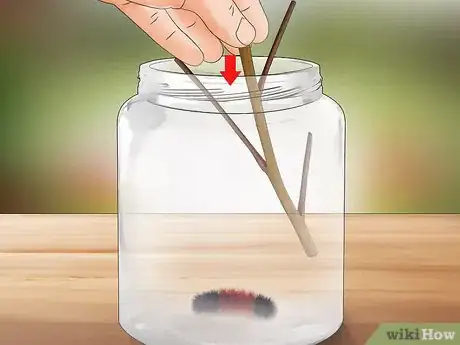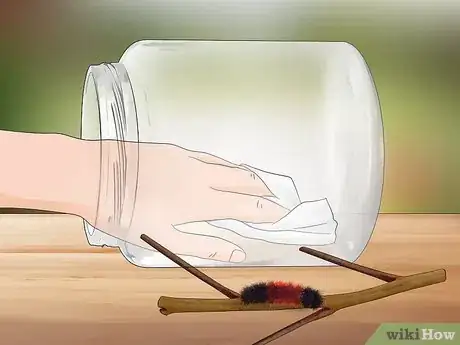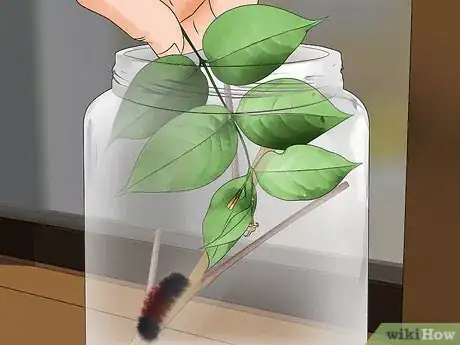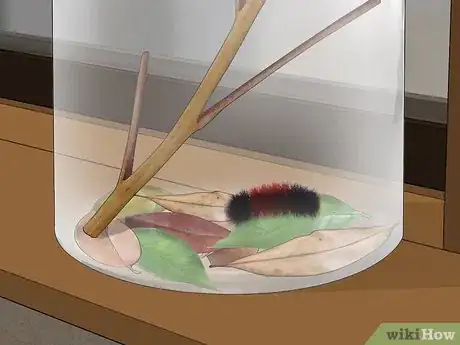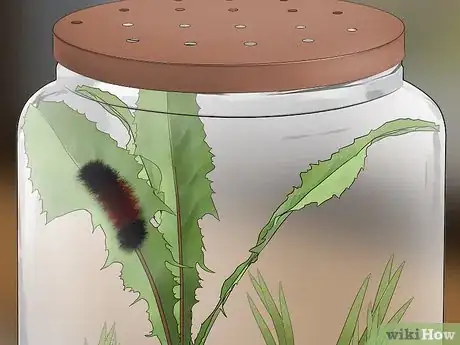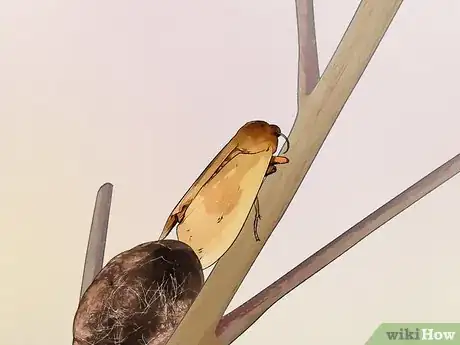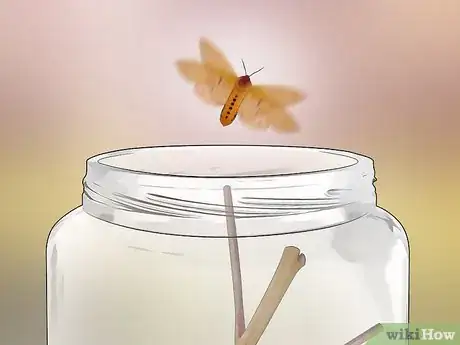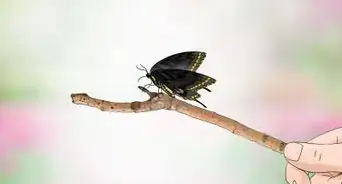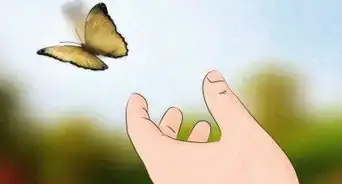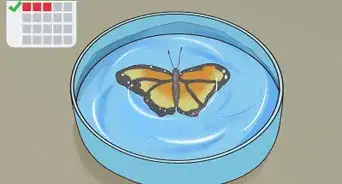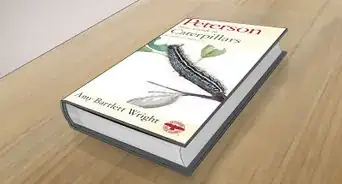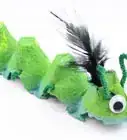This article was co-authored by Samuel Ramsey, PhD. Dr. Samuel Ramsey is an Entomologist and a researcher with the United States Department of Agriculture. Dr. Ramsey has extensive knowledge of symbiosis and specializes in insect disease spread, parasite behavior, mutualism development, biological control, invasive species ecology, pollinator health, and insect pest control. He holds a Bachelor’s degree in Entomology from Cornell University and a Ph.D. in Entomology from the University of Maryland. Dr. Ramsey’s research on bees has enabled researchers to develop targeted control techniques to restore honey bee populations worldwide. He also hosts a YouTube series called “Dr. Buggs.”
wikiHow marks an article as reader-approved once it receives enough positive feedback. This article received 37 testimonials and 90% of readers who voted found it helpful, earning it our reader-approved status.
This article has been viewed 509,273 times.
Woolly bears, the caterpillar form of the Tiger Moth, are a well-known sign of spring in North America. These charmingly fluffy caterpillars can be raised to adults at home as an educational project for children, or simply for aesthetic pleasure. You will need to provide your caterpillars with a solid habitat, feed them, and then release them into the wild once they turn into moths.
Steps
Providing the Right Habitat
-
1Use the right container. You can safely keep a woolly bear caterpillar in a clear plastic jar, like a mason jar. The jar should have a lid to prevent the caterpillar from escaping. You can also use a cardboard box.[1]
- You should punch small holes on the lid. You can also use a mesh lid. It's important for the jar to have some air circulation.
-
2Provide twigs. Your caterpillar will need a twig to build a cocoon. Place a small twig or branch from outside in the caterpillar's jar. Angle the branch in a diagonal fashion, as this will allow the caterpillar to climb onto it when it's ready to build its cocoon.[2]Advertisement
-
3Clean the container regularly. Each day, you will notice the caterpillar has left droppings in the container. These should be cleaned out regularly. You can move the caterpillar out of the container and use a tissue paper to wipe up droppings.[3]
-
4Keep the container outside. Woolly bear caterpillars need a cold environment to thrive. You should keep the container in a secure location outdoors. Something like a garage or shed near your house is a safe place to keep your caterpillar.[4]
Feeding Your Caterpillar
-
1Provide plants from where you found your caterpillar. Caterpillars will do best feeding off their original host plants. Remove some of the leaves and plants from where you found your caterpillar. Place them in the caterpillar's container.[5]
- For example, if you found your caterpillar on a tree in your yard, remove leaves from that tree of your caterpillar's home.
-
2Feed your caterpillar leaves. Caterpillars can benefit from eating leaves from outdoors. If you find leaves on the ground, bring them in from outdoors. Scatter them on the bottom of your caterpillar's container. Green and dry leaves can both work. You should feed your caterpillar leaves daily.[6]
-
3Add flowers and grasses. Caterpillars also eat flowers and grass, so bring those in from outdoors as well. Things like dandelions, grass, plantains, and burdock can be great to help a caterpillar thrive. Provide fresh flowers daily.[7]
-
4Mist the cage regularly. Wooly Bear Caterpillars do not need a water container and it can actually be a drowning hazard. However, misting the environment is important. Each day, use a spray bottle to mist the bottom of the container. Small droplets of water can help a Wooly Bear Caterpillar stay hydrated.[8]
Releasing Your Caterpillar
-
1Place dead leaves in the container during winter. When winter comes, add dead leaves to the caterpillar's container. This will allow the caterpillar somewhere warm to sleep during the colder months. Eventually, the caterpillar will build a cocoon, but it will not do so until spring. It's important to keep your caterpillar warm over the winter.[9]
-
2Move the container indoors when your caterpillar builds its cocoon. In the spring, you will notice your caterpillar will stop moving and take to its branch. Eventually, it will build a cocoon. Once the caterpillar has built a cocoon, it is safe to bring it inside. You will be able to better observe the moth inside.[10]
-
3Feed the moth when it emerges. Before the moth emerges, provide extra twigs in the container. You should also add fresh flowers. As you will not be releasing the moth for a few days, it will need these food sources.[11]
-
4Release the moth after two days. You can enjoy your moth for a few days after it emerges. Observe the moth in its container and watch it feed on leaves and grass. If you have young children, this can be a great learning experience. However, after a few days, you should release the moth outdoors near where you found it. A moth cannot comfortably live in a small container the same way a caterpillar can.[12] [13]
Expert Q&A
Did you know you can get expert answers for this article?
Unlock expert answers by supporting wikiHow
-
QuestionWhat do woolly bear caterpillars like to eat?
 Samuel Ramsey, PhDDr. Samuel Ramsey is an Entomologist and a researcher with the United States Department of Agriculture. Dr. Ramsey has extensive knowledge of symbiosis and specializes in insect disease spread, parasite behavior, mutualism development, biological control, invasive species ecology, pollinator health, and insect pest control. He holds a Bachelor’s degree in Entomology from Cornell University and a Ph.D. in Entomology from the University of Maryland. Dr. Ramsey’s research on bees has enabled researchers to develop targeted control techniques to restore honey bee populations worldwide. He also hosts a YouTube series called “Dr. Buggs.”
Samuel Ramsey, PhDDr. Samuel Ramsey is an Entomologist and a researcher with the United States Department of Agriculture. Dr. Ramsey has extensive knowledge of symbiosis and specializes in insect disease spread, parasite behavior, mutualism development, biological control, invasive species ecology, pollinator health, and insect pest control. He holds a Bachelor’s degree in Entomology from Cornell University and a Ph.D. in Entomology from the University of Maryland. Dr. Ramsey’s research on bees has enabled researchers to develop targeted control techniques to restore honey bee populations worldwide. He also hosts a YouTube series called “Dr. Buggs.”
Entomologist Caterpillars have taste buds, and a lot of different kinds of caterpillars will only eat certain kinds of leaves. If you don't have the right kinds of leaves, the woolly bears will not eat them. They prefer dandelion leaves. If you see the dandelions growing out of the ground, if you take some of the leaves off of them and put them into the woolly bear enclosures, they will consume those. They do like maple leaves and birch leaves. Those are good for them but there are more leaves that they will not eat than they will. So, it's important to find the right ones because they are picky eaters.
Caterpillars have taste buds, and a lot of different kinds of caterpillars will only eat certain kinds of leaves. If you don't have the right kinds of leaves, the woolly bears will not eat them. They prefer dandelion leaves. If you see the dandelions growing out of the ground, if you take some of the leaves off of them and put them into the woolly bear enclosures, they will consume those. They do like maple leaves and birch leaves. Those are good for them but there are more leaves that they will not eat than they will. So, it's important to find the right ones because they are picky eaters. -
QuestionCan I keep multiple woolly bear caterpillars in the same enclosure?
 Samuel Ramsey, PhDDr. Samuel Ramsey is an Entomologist and a researcher with the United States Department of Agriculture. Dr. Ramsey has extensive knowledge of symbiosis and specializes in insect disease spread, parasite behavior, mutualism development, biological control, invasive species ecology, pollinator health, and insect pest control. He holds a Bachelor’s degree in Entomology from Cornell University and a Ph.D. in Entomology from the University of Maryland. Dr. Ramsey’s research on bees has enabled researchers to develop targeted control techniques to restore honey bee populations worldwide. He also hosts a YouTube series called “Dr. Buggs.”
Samuel Ramsey, PhDDr. Samuel Ramsey is an Entomologist and a researcher with the United States Department of Agriculture. Dr. Ramsey has extensive knowledge of symbiosis and specializes in insect disease spread, parasite behavior, mutualism development, biological control, invasive species ecology, pollinator health, and insect pest control. He holds a Bachelor’s degree in Entomology from Cornell University and a Ph.D. in Entomology from the University of Maryland. Dr. Ramsey’s research on bees has enabled researchers to develop targeted control techniques to restore honey bee populations worldwide. He also hosts a YouTube series called “Dr. Buggs.”
Entomologist As woolly bears begin to grow, they can be a bit gregarious. Having friends around can be fun for the woolly bears. You can raise a bunch of them together but it's important that you don't end up with a cage so full of woolly bears that everybody is not getting enough food because they do like to crowd each other out. They don't like to have to compete for resources.
As woolly bears begin to grow, they can be a bit gregarious. Having friends around can be fun for the woolly bears. You can raise a bunch of them together but it's important that you don't end up with a cage so full of woolly bears that everybody is not getting enough food because they do like to crowd each other out. They don't like to have to compete for resources.
Warnings
- Don't touch the newly hatched moths, as their wings could be damaged. If they are damaged, they could easily die or become crippled.⧼thumbs_response⧽
References
- ↑ https://www.cuteness.com/article/keep-black-brown-fuzzy-caterpillar
- ↑ https://www.cuteness.com/article/keep-black-brown-fuzzy-caterpillar
- ↑ https://www.cambridgebutterfly.com/wp-content/uploads/2017/12/woolly_bear_brochure.pdf
- ↑ https://www.cambridgebutterfly.com/wp-content/uploads/2017/12/woolly_bear_brochure.pdf
- ↑ https://www.sbnature.org/uploads/pages/WoolyBears-1523472409.pdf
- ↑ https://www.cuteness.com/article/keep-black-brown-fuzzy-caterpillar
- ↑ https://www.cambridgebutterfly.com/wp-content/uploads/2017/12/woolly_bear_brochure.pdf
- ↑ https://www.cuteness.com/article/keep-black-brown-fuzzy-caterpillar
- ↑ https://www.cambridgebutterfly.com/wp-content/uploads/2017/12/woolly_bear_brochure.pdf
- ↑ https://www.cambridgebutterfly.com/wp-content/uploads/2017/12/woolly_bear_brochure.pdf
- ↑ https://www.cambridgebutterfly.com/wp-content/uploads/2017/12/woolly_bear_brochure.pdf
- ↑ https://www.cambridgebutterfly.com/wp-content/uploads/2017/12/woolly_bear_brochure.pdf
- ↑ Samuel Ramsey, PhD. Entomologist. Expert Interview. 20 January 2021.
About This Article
To care for a woolly bear caterpillar, keep it in a sealable container that has holes in the lid for air circulation. You should also put an upright twig in the container so your caterpillar has something to make a cocoon on. Since woolly bear caterpillars need to be in the cold to survive, keep the container somewhere outdoors. To feed your caterpillar, put plants, leaves, flowers, and grasses from the area where you found it into the container. Also, mist the inside of the container with water every day so your caterpillar stays hydrated. To learn how to release a woolly bear caterpillar after it emerges as a moth, scroll down!

